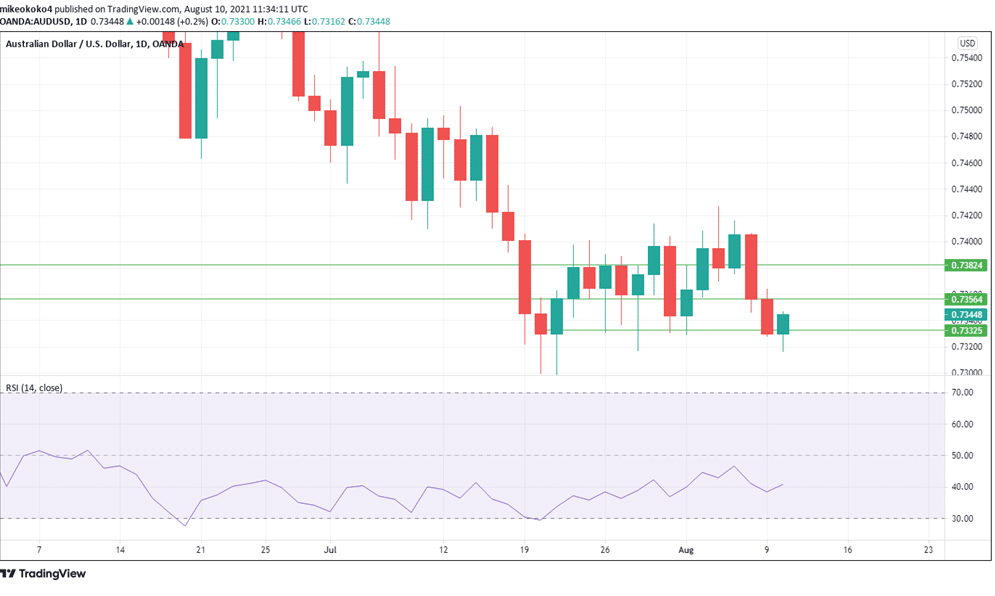
- A strong US jobs data and increased confidence in a looming tapering favor the USD.
- Australian lockdowns and declining iron ore prices eat up the economy as AUD struggles.
- China CPI data may define AUD, but the odds are slim.
The US dollar was marginally down against the Australian dollar, going at $0.73448, at 1134 GMT on Tuesday, as the market continues to respond to strong US jobs data and a rise in the Treasury yields. On Monday, the 10-year Treasurys rose by more than one percent as the strong July Non-Farm Payrolls jobs data provided strong ground for USD to strengthen against AUD for the better part of the week.
US jobs data and China inflation data could define AUDUSD this week
In the meantime, the Australian dollar was in the red, as Covid-19 restrictions and trade uncertainties with China continue to take their toll on the Australian economy.
The latest business confidence survey by National Australia Bank shows a steep decline in business confidence in the nation to -8%, representing a reduction of 19%. This comes at a time when the nation’s most populous city, Sydney, is under an extended lockdown. Victoria state is also under a surprise one-week lockdown which started on Thursday.
The aussie’s moves in the coming days will be dependent on two data releases: one being Australia’s August Westpac Consumer Confidence and the other being China’s July Consumer Price Inflation data. China’s sustained efforts to keep inflation low have seen Australia suffer, as its metal exports to China have been adversely affected.
Therefore, a lower-than-expected CPI from China today may see AUD make marginal gains as it will renew hope of a more relaxed approach by China towards Australia’s exports. The Westpac Consumer Confidence report may, however, do little to change perception over an Australian economy forced into lockdown amid rising Covid-19 infections and less than 20% vaccination level.
The high yield of the US Treasuries is attributed to the strong July Non-Farm Payrolls data, which showed the creation of 943k jobs, surpassing analysts’ estimates of 870k. The dollar has found new strength in not only the strong jobs data but also a Fed that looks increasingly likely to institute a long-awaited tapering.
Fed tapering likely to further strengthen USD as Australia’s economy struggles
The market has taken cues from two of the FOMC members, Boston’s Eric Rosengren and Atlanta’s Raphael Bostic. Rosengren has hinted that the Fed may discuss tapering as soon as September, while Bostic is convinced that US inflation has already met the necessary threshold for the Fed to start talking about tapering.
In addition, Fed Governor Christopher Waller stated last week that an additional 800k-1million jobs in August and September would make him back tapering from next month.
For the Australian dollar, there’s nothing much to suggest that its trajectory should be heading upwards soon. Apart from an economy slowed down by lockdowns, one of Australia’s key exports, iron ore, has been mostly losing since July 20th and was down by 3.75% at 1120 GMT on Tuesday.
The metal is currently down by 25% from its May peak. China’s new struggles with the Delta variant of the Covid-19 pandemic have also dampened hopes of an increase in demand for iron ore.
Technical analysis
According to RSI, AUDUSD market momentum is at 40, depicting a mostly neutral momentum. This is likely to keep the pair trading sideways, with a possibility of long candlestick wicks.

A bullish control is likely to push the price to test the first resistance at $0.73564, and a stronger push will attempt at $0.73824. If the bears have their way, then support is likely to be established at $0.73325.








Leave a Reply